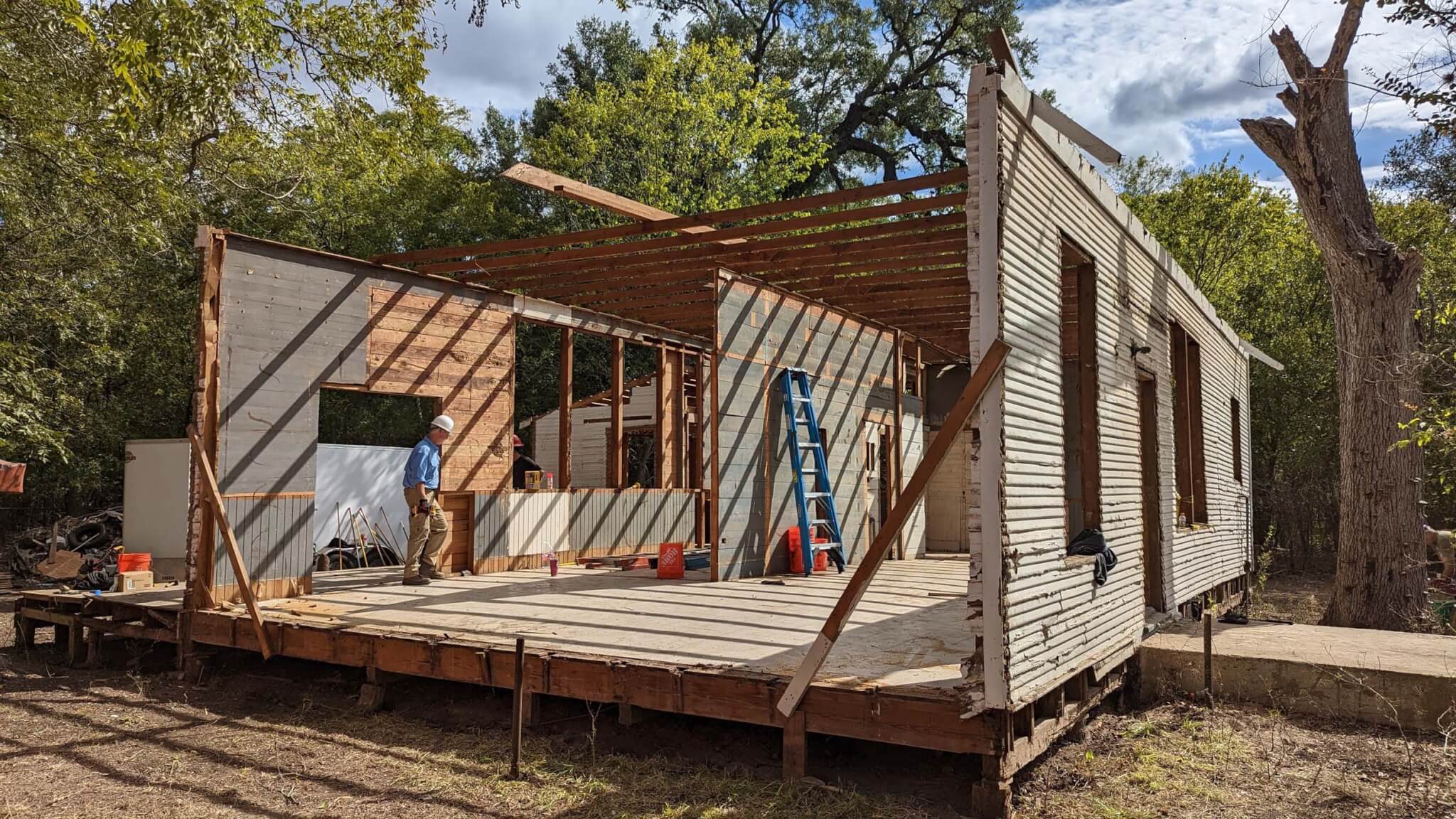Demolition markets and designing for construction and deconstruction aren’t utopian fantasies. Across the world, resourceful leaders are disrupting old models to write a new chapter about the way buildings are made and unmade. Regenerative design as a practice goes beyond minimizing negative effects of the design and construction industry to create restorative, renewable systems. These three innovators are harnessing building technology and design to reimagine construction as an ally for regenerative design, giving practitioners tangible options to support circular economies in their work. They’re seeing firsthand how they can be part of seismic shifts that decouple cities and communities from unsustainable financial drivers through deconstruction.
Material Innovation Center
At a decommissioned air force base in Port San Antonio, Texas, the new Material Innovation Center (MIC), founded by the Office of Historic Preservation and San Antonio City Council, is fighting a multifront battle where cultural erasure, rapid development, and financial insecurity are in lockstep with ecological pressures. Stephanie Phillips, senior program manager for deconstruction in circular economies in the Office of Historic Preservation, describes her work at the MIC as three-pronged: “We receive and redistribute donated building materials for affordable housing and community impact projects, provide trades education, and we’re currently working on setting up a community tool library.” The result is a landfill alternative and responsible resource for the next generation of builders, all housed in a series of 25 MIC-owned historic bungalow structures.
Education is a key component in the success of the MIC. Students receive classroom instruction as well as paid apprenticeships for hands-on wood window and architectural carpentry courses to rehabilitate the MIC bungalows. The robust program partners with wraparound services that help with child care, transportation, emergency groceries, or anything students may need to complete their training. “They get paid to learn, and then they move on to an eight- to ten-week paid apprenticeship under one of our local master deconstruction contractors at a different site so they can hone those skills and become certified contractors themselves,” Phillips explained. “It’s an integral part to any city that’s looking to develop an actual policy around deconstruction.”

Circular Construction Lab
Moving an industry away from current methods of construction and demolition requires data. Felix Heisel, an assistant professor at Cornell and director of its Circular Construction Lab (CCL), links technology to practical solutions. “Our application RhinoCircular gives students and practicing architects a tool to measure circularity in early design phases,” he told AN. The extension works with CAD application Rhinoceros 3D and Grasshopper to assess a building’s environmental impact in construction and deconstruction. “It calculates two aspects: the material pathways in weight of all the materials in your building, and their circularity in percent. For example, it will tell you x kilograms of material come from reused sources, and y come from renewable sources. It will also highlight problems, where materials are destined for landfill.”
In 2022, Heisel and the CCL took on real-world demonstrations with the Catherine Commons Deconstruction Project in Ithaca, New York. A grant from the Einhorn Center at Cornell, as well as partnerships with local firm Trade Design Build and nonprofit Finger Lakes ReUse, allowed them to deconstruct a single-family residence side-by-side with a similar home being demolished as a comparison. “In the end, we took only five days to take down a 3-story residential structure, and we didn’t have a large additional cost,” Heisel said.
Recently, the CCL in partnership with Urban Machine, Finger Lakes ReUse, and Build Reuse has had the opportunity to expand: In July, the partners received an EPA grant of $2.5 million to develop a product catalog for salvaged materials. “There shouldn’t be any question about whether this is a good idea or not,” Heisel said, but he knows that the same barriers the industry faces could also be potential levers: policy, codes, and legislation. Currently, the CCL is working on a white paper for the New York State Assembly and Senate that outlines 15 policy recommendations for implementing circular strategies.

Assemblage
Outside of start-ups and universities, practitioners are also beginning to incorporate circular economies into private commissions. Landscape architect Wendy Andringa founded her Brooklyn-based firm Assemblage in 2021 with a circular systems approach to design and activism as core tenets. “These values make the work richer,” she said.
Andringa considers her work like that of a detective: “We look at the history and maps, but also depend a lot on our observations to try to see things in all seasons.” Assemblage’s work offers material narratives that center land stewardship and seek to uncover the mysteries of material flows. A helpful strategy to do this is mapping, which Andringa tested with her Dolly’s Park project. The new park turns an underused gravel-filled lot in Gowanus, Brooklyn, into an accessible greenspace, and it was an experiment for Andringa to “investigate the provenance of all materials that went into the park,” she explained. The team used a platform called Open Source Mapping. “The software gave us the capability to talk about the history and sources of the materials, and that was the first pilot map.”


There has been an explosion of ideas on how to make design and construction more green and environmentally responsive. Yet policy and legislation are lagging behind technology, pedagogy, and practice. Amid an ongoing fervor for climate solutionism in architecture and construction, it’s urgent that we pivot to circular strategies as a new path forward. These innovators are already leading the way to build our sustainable future.
Jes Deaver is a writer and architect at Nick Deaver Jes Deaver Architecture. She is also the H. Deane Pierce Endowed Visiting Assistant Professor at Texas Tech University.

